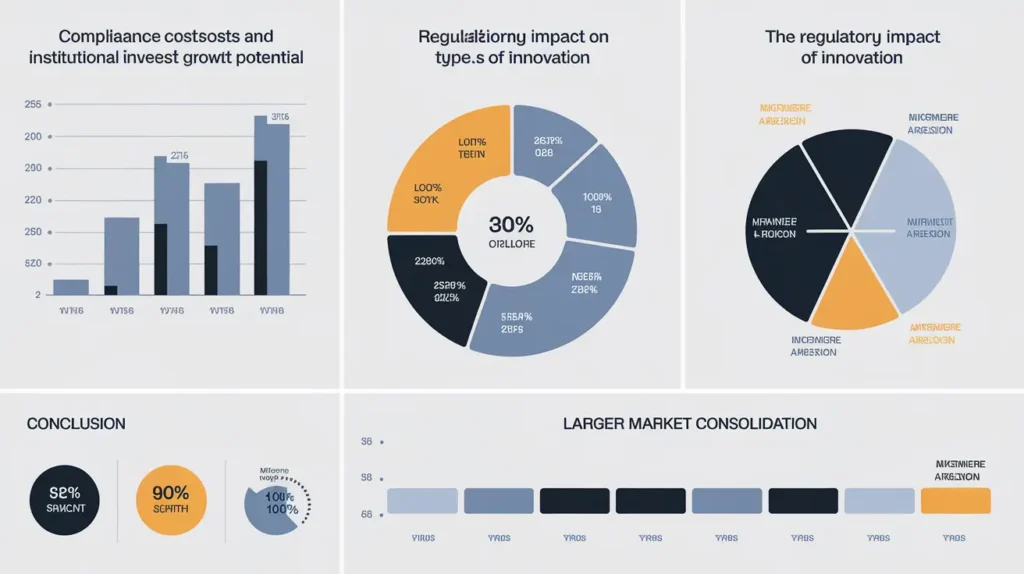The EU’s MiCA Regulation Overview is a major turning point for the crypto industry in Europe. With MiCA (Markets in Crypto-Assets) coming into full effect in 2024, it establishes a comprehensive, standardized regulatory framework for the entire EU crypto sector.
This groundbreaking regulation covers various facets, from stablecoin regulations to crypto-asset service providers (CASPs), enhancing transparency, consumer protection, and operational stability. The MiCA regulation details promise to reshape the EU’s crypto landscape, fostering a more secure and compliant environment.
Overview of MiCA Regulation and Its Scope
MiCA (Markets in Crypto-Assets) is a significant regulatory development in the European Union, designed to bring harmony and clarity to the crypto sector. Its primary objective is to unify the regulation of digital assets across the EU’s member states, creating a single, standardized regulatory framework.
This is critical in addressing previously fragmented and inconsistent crypto laws, which often varied by country. MiCA covers a broad range of crypto-related activities, including stablecoin regulation, crypto-asset service providers (CASPs), and consumer protections. By setting clear standards, MiCA aims to ensure that businesses operating within the EU are subject to the same rules, enhancing transparency, security, and legal certainty in the market.
Key Components of EU’s MiCA Regulation Overview
MiCA’s regulatory framework is comprehensive, addressing several critical areas of the crypto market. These include the regulation of stablecoins, the authorization of crypto-asset service providers (CASPs), and enhanced consumer protection measures.
- Stablecoin Regulation: MiCA sets stringent rules for stablecoins, requiring issuers to maintain sufficient reserves and comply with strict governance standards. This applies to both e-money tokens (EMTs) and asset-referenced tokens (ARTs), ensuring that these digital assets are stable and reliable for consumers.
- CASP Authorization: MiCA mandates that all crypto-asset service providers, including exchanges and wallet providers, must obtain authorization to operate within the EU. This requires meeting specific criteria, including capital adequacy, governance, and operational standards.
- Consumer Protection: One of MiCA’s core focuses is safeguarding consumers. This includes ensuring transparency in crypto transactions, providing clear information to users, and implementing protections against market manipulation and fraud.
Summary of MiCA’s Key Regulatory Components:
| Regulation Area | Description | Compliance Requirements |
|---|---|---|
| Stablecoin Rules | Applies to EMTs and ARTs; issuers must hold reserves and meet governance standards | Reserve management, governance, transparency |
| CASP Authorization | Requires authorization for service providers like exchanges and wallet providers | Capital adequacy, operational standards, governance |
| Consumer Protection | Ensures market integrity and protects consumers from fraud and market manipulation | Transparency, fraud prevention, consumer rights |
Timeline for MiCA Implementation
MiCA’s implementation will occur in phases. The first rules, specifically targeting stablecoin regulation, will take effect by June 2024. By December 2024, the full framework will be in place, covering all aspects of the crypto market, including CASPs and consumer protections.
The phased rollout gives businesses time to adjust to the new regulations and ensures that all entities are compliant by the end of 2024.
Key Dates
- June 2024: Stablecoin rules take effect.
- December 2024: Full MiCA implementation, including CASP regulations and consumer protections.
- Timeline allows for a gradual transition, giving crypto businesses the time needed to ensure full compliance.
Governance and Risk Management
One of the critical components of MiCA is its focus on governance and risk management. Crypto businesses must adhere to strict governance frameworks that ensure proper oversight, risk management, and transparency in their operations.
MiCA introduces requirements for companies to establish robust risk management procedures to protect against market risks, fraud, and cybersecurity threats. Additionally, businesses must regularly report on their compliance status, ensuring that they meet all operational standards outlined by the regulation.
- Governance Requirements: All crypto businesses operating under MiCA must establish clear governance structures, with defined roles and responsibilities to oversee operations and compliance.
- Risk Management: MiCA mandates the implementation of effective risk management frameworks to mitigate financial, operational, and cybersecurity risks. This includes detailed reporting to ensure businesses are adhering to risk management protocols.
- Transparency: Businesses must provide clear, transparent reports on their activities, including financial stability, compliance with MiCA standards, and operational integrity.
Related articles
- Impact of MiCA on Self-Hosted Wallets
- EU Crypto Investor Rights under MiCA
- MiCA’s Role in Enhancing Crypto Market Transparency
- MiCA’s Regulatory Framework for Stablecoins
- MiCA Compliance for Digital Asset Trading Platforms
Impact of MiCA on Stablecoins and Digital Assets
Stablecoins are a central focus of the EU’s MiCA Regulation, particularly due to their growing role in the financial ecosystem. With stringent rules set to take effect in mid-2024, MiCA seeks to regulate asset-referenced tokens (ARTs) and e-money tokens (EMTs) by introducing clear compliance and operational guidelines. These regulations are intended to ensure financial stability and provide greater transparency and consumer protection across the EU’s digital asset market.
MiCA Requirements for Stablecoin Issuers
Under MiCA, stablecoin issuers are required to adhere to several key regulatory measures to ensure the integrity and stability of the market. These requirements include:
- Reserve Requirements: Issuers of stablecoins, particularly ARTs and EMTs, must maintain sufficient financial reserves to back their tokens. This ensures that the stablecoins are always redeemable and pegged to their underlying assets, minimizing the risk of collapse. The regulation specifies that reserves should be high-quality, liquid assets, ensuring immediate redemption rights for holders.
- Transparency Measures: Issuers must provide clear and regular reports on their reserve holdings, governance structure, and operational health. Transparency is key in maintaining trust with investors and regulators, ensuring that stablecoins operate within a safe and compliant environment.
- Safeguarding Assets: Issuers must safeguard their assets in a manner that protects users from insolvency or fraud. MiCA emphasizes the need for stablecoin issuers to implement robust security measures to protect against cyber threats and financial mismanagement.
The Shift Toward Euro-Backed Stablecoins
As MiCA takes effect, there has been a noticeable shift among stablecoin issuers, particularly those issuing non-compliant stablecoins like Tether (USDT), to exit the EU market. This has created room for the rise of euro-backed stablecoins, which comply with MiCA’s strict regulations.
- Exiting Non-Compliant Issuers: Stablecoin issuers that do not meet MiCA’s reserve and transparency requirements have already begun to withdraw from the EU market, reducing the availability of certain tokens. Exchanges, such as Binance and Bitstamp, have already delisted some non-compliant stablecoins, creating a shift toward more compliant options.
- Growth of Euro-Backed Stablecoins: MiCA’s compliance requirements have encouraged issuers to develop euro-backed stablecoins, which are seen as more stable and reliable. These tokens are expected to dominate the market, as they provide better financial security for consumers and ensure compliance with the regulation.
Consumer Protections for Stablecoin Holders
One of the most critical aspects of MiCA is the consumer protection it provides for stablecoin holders. These measures are designed to ensure that users have safe and secure access to stablecoins, particularly in times of financial uncertainty.
- Redemption Rights: Holders of EMTs, under MiCA, are granted guaranteed redemption rights, ensuring they can exchange their stablecoins for the underlying assets at any time. This helps protect users from the risk of token devaluation or issuer insolvency.
- Enhanced Transparency: MiCA also introduces higher standards for transparency, requiring issuers to disclose key information about their reserves, governance, and token mechanics. This transparency is aimed at building consumer confidence in stablecoins and reducing the risk of fraud.
- Market Integrity: By enforcing clear consumer protection rules, MiCA aims to create a more secure environment for retail investors. The regulation reduces the risks of market abuse, manipulation, and insider trading, giving users greater confidence in the stability and security of the assets they hold.
Regulatory Impact on Crypto-Asset Service Providers (CASPs)

The Markets in Crypto-Assets (MiCA) regulation introduces rigorous requirements for crypto-asset service providers (CASPs) operating within the European Union. MiCA aims to bring consistency to the market by ensuring all CASPs follow the same standards regarding authorization, compliance, and transparency. For businesses in the EU crypto market, understanding and meeting these obligations is essential to continue their operations.
Authorization Process for CASPs
Under MiCA, CASPs are required to go through a formal authorization process before they can operate within the EU. This process is overseen by the National Competent Authorities (NCAs) in each member state and is essential for ensuring that CASPs meet the operational and financial standards set forth by MiCA.
Authorization Process Steps:
- Filing Notification: CASPs must submit a formal application to the NCA, outlining their business operations, governance structure, and financial health.
- Prudential Requirements: CASPs are required to demonstrate that they meet the prudential requirements set by MiCA, which include holding sufficient capital reserves, establishing proper governance, and implementing risk management frameworks.
- Approval Milestones: The NCA will review the application and provide feedback. If approved, the CASP will receive the necessary licenses to operate within the EU, but ongoing compliance checks are required.
Checklist for MiCA Authorization:
- Submit comprehensive business documentation to the NCA.
- Meet MiCA’s prudential requirements, including governance and capital reserves.
- Receive approval and maintain ongoing compliance with operational standards.
Transparency and Reporting Obligations
MiCA places a strong emphasis on transparency, requiring CASPs to adhere to strict reporting standards to promote accountability and market integrity. These obligations ensure that CASPs provide regular updates on their operations and financial status to the relevant authorities, particularly the National Competent Authorities (NCAs).
- Regular Reporting: CASPs must report key operational data, including trading volumes, user data security measures, and capital reserves, on a routine basis. This ensures that regulators have a clear understanding of the CASP’s activities and can take action if irregularities are identified.
- Disclosure Requirements: CASPs are also obligated to disclose relevant information to their clients, including risks associated with the assets they handle, transaction details, and service fees. This transparency is designed to enhance consumer protection and maintain trust in the crypto market.
- Compliance Audits: CASPs are subject to periodic compliance audits to verify that they are meeting MiCA’s requirements. Failure to comply with these standards can result in penalties or the revocation of their authorization to operate within the EU.
Enhancing Market Integrity and Consumer Protection

The Markets in Crypto-Assets (MiCA) regulation is designed not only to regulate the crypto market but also to ensure market integrity and robust consumer protection. MiCA sets forth comprehensive rules to safeguard users, particularly retail investors, from market abuse while ensuring transparent and fair operations across the crypto sector.
MiCA’s Role in Preventing Market Abuse
One of MiCA’s primary objectives is to tackle market abuse and ensure a fair trading environment within the EU’s crypto market. Market abuse—ranging from insider trading to price manipulation—has long been a concern in the crypto space, where regulations have been inconsistent or lacking.
- Market Abuse Rules: MiCA introduces stringent measures to prevent insider trading, market manipulation, and fraud. By setting clear guidelines on prohibited activities, the regulation aims to create a level playing field for all market participants. These rules are modeled after existing regulations for traditional financial markets, such as the EU’s Market Abuse Regulation (MAR), ensuring crypto markets adhere to similar standards.
- Ensuring Transparency: MiCA mandates disclosure requirements for crypto businesses, which play a key role in preventing market manipulation. By requiring CASPs and issuers to provide transparent information about token offerings and trading activities, MiCA reduces the risks of hidden agendas and ensures that users can trust the system.
- Monitoring and Enforcement: Regulatory bodies, such as the European Securities and Markets Authority (ESMA), will oversee compliance with MiCA’s market abuse rules. These authorities have the power to investigate suspicious activities and enforce penalties, ensuring that crypto markets remain fair and transparent.
Consumer Protections Under MiCA
MiCA also emphasizes consumer protection, particularly for retail investors who may be vulnerable to risks in the crypto market. By introducing a set of measures aimed at safeguarding investors’ rights and ensuring transparent operations, MiCA enhances trust and confidence in the industry.
- Clear Disclosure Requirements: One of the key consumer protection measures under MiCA is the requirement for transparency in how crypto services and tokens are offered. CASPs are obligated to provide clear, comprehensible information on their services, token mechanics, associated risks, and pricing structures. This helps users make informed decisions and reduces the risk of falling victim to fraudulent schemes or hidden fees.
- Safeguards for Token Holders: For token holders, MiCA introduces measures to protect their rights, such as redemption options for certain token types like e-money tokens (EMTs). These rules ensure that users can redeem their assets or receive equivalent value in fiat currency, protecting them from losses in case of market instability or issuer failure.
- Investor Rights and Dispute Resolution: MiCA also requires CASPs to have clear complaint handling procedures in place, ensuring that retail investors have access to efficient channels for resolving disputes. By enhancing the rights of consumers, MiCA strengthens protections for those who may not have the resources to challenge unfair practices.
Challenges and Opportunities for Crypto Businesses Under MiCA

The Markets in Crypto-Assets (MiCA) regulation represents a significant shift for the crypto industry within the EU, offering both challenges and opportunities for businesses. While the regulation brings clarity, which is crucial for long-term stability, it also introduces new compliance burdens that firms must navigate.
Compliance Challenges for Crypto Firms
MiCA’s robust regulatory framework, while providing legal certainty, poses several challenges for crypto firms, particularly smaller businesses. Key issues include:
- Regulatory Burden: One of the most significant challenges under MiCA is the increased regulatory burden, especially for startups and smaller firms. These businesses now need to comply with detailed requirements regarding capital reserves, reporting standards, and governance structures.
Note
Many smaller firms may find it difficult to allocate resources toward meeting these compliance needs, increasing operational costs.
- Compliance Costs: Adhering to MiCA’s guidelines, particularly the requirements for transparency and consumer protection, will likely increase the cost of doing business. Companies must invest in new technology, legal counsel, and risk management practices to ensure compliance, which could be a substantial financial outlay, especially for firms that operate with lean resources.
- Risk of Non-Compliance: Failure to meet MiCA’s standards could result in significant penalties, including fines or the revocation of authorization to operate in the EU. The complexity of the compliance landscape means that firms must ensure ongoing vigilance to avoid violations. This increases both administrative costs and operational risks for businesses.
Opportunities for Growth and Market Entry
Despite the challenges, MiCA also offers substantial opportunities for growth and market entry, particularly for larger institutional players and firms that prioritize compliance.
- Attracting Institutional Investors: MiCA’s clear regulatory framework provides the transparency and legal certainty that institutional investors seek. As a result, many larger financial institutions that were previously hesitant to enter the crypto space are now more likely to invest in or partner with compliant crypto firms. This opens up new avenues for capital inflow and strategic partnerships within the industry.
- Increased Innovation: The regulation also fosters innovation within the crypto space, particularly in areas like stablecoins and DeFi. By establishing clear rules, MiCA encourages businesses to explore new products and services that can comply with the law while also meeting the growing demand for decentralized financial solutions.
- Market Consolidation: MiCA’s stringent requirements may lead to market consolidation, where larger, well-funded firms absorb smaller players who cannot keep up with the regulatory demands. This can result in a more streamlined and competitive market, with compliant firms gaining a stronger foothold and benefiting from reduced competition.
The Markets in Crypto-Assets (MiCA) regulation represents a pivotal moment in the evolution of cryptocurrency within the European Union. It addresses long-standing concerns around market integrity, consumer protection, and compliance standards.
While it introduces substantial challenges for crypto businesses, particularly regarding compliance costs and regulatory requirements, it also opens doors for growth, innovation, and institutional investment. By offering a harmonized regulatory framework, MiCA not only brings legal clarity but also fosters trust, which is essential for the sustainable development of the crypto market in the EU.
As MiCA moves toward full implementation in 2024, businesses that prioritize compliance and innovation will be well-positioned to thrive in this new regulatory environment. For investors and crypto users alike, MiCA promises a more secure, transparent, and reliable marketplace, with stronger protections and clearer guidelines for all participants.



















